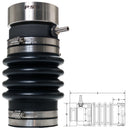Description
3" Shaft - 5-1/2" Stern Tube
The PSS Shaft Seal is the #1 selling marine mechanical seal worldwide and is installed as standard equipment by many of the worlds most reputable boat builders and boat yards. The PSS Shaft Seal is also recognized as the premiere retrofit (aftermarket) seal on the world market. Boat builders and boat yards recognize the advantages and value of installing the PSS as it eliminates the maintenance, constant adjustment & cost associated with traditional packing type glands. Aside from these benefits, the PSS Shaft Seal helps to eliminate water in the bilge (100% water tight) & wear to the propeller shaft.
How Does it Work?
1. Two nitrile o-rings seal the stainless steel rotor to the shaft and will not experience wear.
2. A primary set screw and a backup set screw (2 sets) are used to secure the stainless steel rotor to the shaft.
3. A seal is created between the two flat surfaces of the carbon stator and the stainless steel rotor.
4. Water is fed into the PSS Shaft Seal for cooling/lubricating the seal faces on high speed vessels.
5. The stationary carbon stator is attached to the nitrile bellow, which is attached to the stern tube (shaft log).
Rotor
The PSS stainless steel rotor is slid down the shaft and is secured to the shaft with set screws at 90° for maximum holding power. Precision tolerances are maintained by computer controlled lathes. The faces have a number 9 micro finish and are perpendicular to the bore to prevent run-out as the collar rotates. The carbon graphite stator will polish the face of the rotor during the first few minutes of operation. The stainless steel rotor should not need to be replaced under normal operating conditions. The stainless steel rotor used on the PSS Type A Shaft Seal is made from 316L stainless steel.
Carbon Stator
The high density, resin impregnated carbon/graphite stator is a composite that is first mixed, molded and then formed under pressure. The blanks are then baked, machined and lapped. The face of our carbon is finished to a flatness of 4 helium light bands (measured .000044" of variation over entire lapped surface). The grade of carbon used in the PSS has an operating temperature over 500° Fahrenheit (+260° Celsius), and cannot melt if the seal runs dry, unlike a rubber lip seal or plastic face seal. The high density of the carbon greatly increases the longevity and wear resistance. Several commercial vessels have recorded over 40,000 (over 4-1/2 years of continuous operation) engine hours on the same, original components. The carbon should not need to be replaced under normal operating conditions.
Bellow
The PSS Type A Shaft Seal bellow is made from rubber (Nitrile), and has a temperature rating of -25°F to +225°F (-31°C to +107°C). Nitrile is known for its resistance to weathering. Nitrile rubber is exceptionally resistant to oils and non-polar solvents. It also offers good gas impermeability, abrasion resistance, and better thermal stability than most general purpose elastomers.
Hose Barb
For high speed vessels it is required that a positive water supply be plumbed to the PSS Shaft Seal for the purpose of lubricating and cooling the seal faces. There are many sources of water supply, review the PSS Shaft Seal Installation Instructions for more information and note all plumbing must follow the standards and practices of proper boat plumbing. In most cases a slow speed boat that does not have a bearing the shaft log does not require positive water feed and can simply be "vented". Ideally the vent line will be run at least 2-3 feet above the water line and is close to the center line as possible to ensure the vent hose is never below the water line, even if the boat heels. Review the PSS Shaft Seal Installation Instructions for more details on venting the seal.
Payment & Security
Your payment information is processed securely. We do not store credit card details nor have access to your credit card information.


